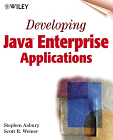Cutting Edge Enterprise Solutions, Well Explored
All the latest technologies, including JSP, EJB, JMS and JTA, defined, exposed, explored and well delivered.
ORIGINAL DRAFT
A big part of Java’s appeal is its strength in enterprise environments. With technologies and APIs like JDBC (Java Database Connectivity), JNDI (Java Naming and Directory Interface), Servlets, JSP (Java Server Pages), RMI (Remove Method Invocation), EJB (Enterprise JavaBeans), JMS (Java Messaging Services), JTA (Java Transaction API) and multi-tiered architectures, few limitations remain and adoption is widespread. This book does a great job of bringing all these topics under a single cover and explores some cutting edge technologies in a way that makes this book a great buy for any serious Java developer.
The books starts with the requisite introduction to enterprise development and first addresses database connectivity with two chapters about JDBC. The first talks about what JDBC has to offer and the second provides examples and explores advanced features of JDBC 2.0, the most recent standard from Sun. The JNDI provides a common means of address name space organization across different types of naming structures. The coverage is spread across chapters 5 and 6. Servlets provide a vehicle for implementing incredibly powerful solutions and rate three chapters in this book, culminating in the implementation of a basic search engine in Java.
An even more recent emerging standard for Java is the JSP. Java Server Pages are comparable to Microsoft’s proprietary ASP (Active Server Pages). Because JSP is a standard, you can already find it in server products like the Java Web Server and Servlet engines like JRun and ServletExec, which are considerably more platform and web server-independent. The JSP coverage spreads across chapters 9 to 11, leading up to a basic online store implementation, which is both instructive and well developed. Chapter 12 looks at distributed objects, with a focus on RMI in chapter 13 and a file-locking example in chapter 14.
Of considerable interest is the coverage of Enterprise JavaBeans, which gets under way in Chapter 15 and continues through programming and deployment coverage in two subsequent chapters, building a business rule engine in chapter 18. Related technologies like the Java Messaging API and the Java Transaction API are relatively new and affect Enterprise JavaBean development directly. This coverage is extensive and explored in chapters 19 to 23. Chapter 24 reviews these concepts and chapter 25 uses this collection of knowledge to build a four-tiered online store. Chapter 26 even implements a basic Java Messaging Service provider.
All in all this book is key to understanding emerging Java standards. It is the first to cover Enterprise JavaBeans in any significant way and provides numerous useful examples to help realize the benefits and understand the critical concepts surrounding this kind of technological solution. If you plan to develop with any of the aforementioned technologies, be it simple JDBC or complex transaction services, this book brings a lot to the table. Enterprise solutions are challenging and typically multi-faceted. You can get the scoop on the latest, along with pragmatic implementation advice and examples from this book, making it a good choice for any serious Java developer.
